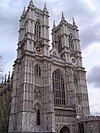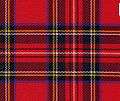Portal:United Kingdom
The United Kingdom Portal
 |
 |

| |
The United Kingdom of Great Britain and Northern Ireland, commonly known as the United Kingdom (UK) or Britain, is a country in Northwestern Europe, off the coast of the continental mainland. It comprises England, Scotland, Wales, and Northern Ireland. The UK includes the island of Great Britain, the north-eastern part of the island of Ireland, and most of the smaller islands within the British Isles, making up a total area of 94,354 square miles (244,376 km2). Northern Ireland shares a land border with the Republic of Ireland; otherwise, the United Kingdom is surrounded by the Atlantic Ocean, the North Sea, the English Channel, the Celtic Sea, and the Irish Sea. The United Kingdom had an estimated population of over 68.2 million people in 2023. The capital and largest city of both England and the United Kingdom is London, whose wider metropolitan area is the largest in Western Europe, with a population of 14.9 million. The cities of Edinburgh, Cardiff, and Belfast are the national capitals of Scotland, Wales, and Northern Ireland, respectively.
The lands of the UK have been inhabited continuously since the Neolithic. In AD 43 the Roman conquest of Britain began; the Roman departure was followed by Anglo-Saxon settlement. In 1066, the Normans conquered England. With the end of the Wars of the Roses the English state stabilised and began to grow in power, resulting by the 16th century in the annexation of Wales, the domination of Scotland, and the establishment of the British Empire. Over the course of the 17th century, the role of the British monarchy was reduced, particularly as a result of the English Civil War. In 1707, the Kingdom of England and the Kingdom of Scotland united under the Treaty of Union to create the Kingdom of Great Britain. The Acts of Union 1800 incorporated the Kingdom of Ireland to create the United Kingdom of Great Britain and Ireland in 1801. Most of Ireland seceded from the UK in 1922 as the Irish Free State, and the Royal and Parliamentary Titles Act 1927 created the present United Kingdom.
The UK became the first industrialised country and was the world's foremost power for the majority of the 19th and early 20th centuries, particularly during the "Pax Britannica" between 1815 and 1914. At its height in the 1920s, the British Empire encompassed almost a quarter of the world's landmass and population, and was the largest empire in history. However, its involvement in the First World War and the Second World War damaged Britain's economic power and a global wave of decolonisation led to the independence of most British colonies. (Full article...)
Featured article
The Coronation of the British monarch is a ceremony in which the monarch is formally crowned and invested with regalia. The coronation usually takes place several months after the death of the previous monarch, for the coronation is considered a joyous occasion that would be inappropriate when mourning still continues. For example, Elizabeth II was crowned on June 2, 1953, having ascended to the throne on February 6, 1952. The ceremony is officiated by the Archbishop of Canterbury, the most senior cleric of the Church of England. Many other government officials and guests attend. (Full article...)
Featured biography
Sir William Bruce of Kinross, 1st Baronet (c. 1630 – 1710), was a Scottish gentleman-architect, "the effective founder of classical architecture in Scotland," as Howard Colvin observes. As a key figure in introducing the Palladian style into Scotland, he has been compared to the pioneering English architects Inigo Jones and Christopher Wren, and to the contemporaneous introducers of French style in English domestic architecture, Hugh May and Sir Roger Pratt.
Bruce was a merchant in Rotterdam during the 1650s, and played a role in the Restoration of Charles II in 1659. He carried messages between the exiled king and General Monck, and his loyalty to the king was rewarded with lucrative official appointments, including that of Surveyor General of the King's Works in Scotland, effectively making Bruce the "king's architect". His patrons included John Maitland, 1st Duke of Lauderdale, the most powerful man in Scotland at that time, and Bruce rose to become a member of Parliament, and briefly sat on the Scottish Privy Council.
Despite his lack of technical expertise, Bruce became the most prominent architect of his time in Scotland. He worked with competent masons and professional builders, to whom he imparted a classical vocabulary; thus his influence was carried far beyond his own aristocratic circle. Beginning in the 1660s, Bruce built and remodelled a number of country houses, including Thirlestane Castle for the Duke of Lauderdale, and Prestonfield House. Among his most significant work was his own Palladian mansion at Kinross, built on the Loch Leven estate which he had purchased in 1675. As the king's architect he undertook the rebuilding of the Royal Palace of Holyroodhouse in the 1670s, which gave the palace its present appearance. After the death of Charles II Bruce lost political favour, and later, following the accession of William and Mary, he was imprisoned more than once as a suspected Jacobite. However, he managed to continue his architectural work, often providing his services to others with Jacobite sympathies. (Full article...)
General images -
Subportals
WikiProjects
Things you can do
- Visit the British Wikipedians' notice board.
- The noticeboard is the central forum for information and discussion on editing related to the United Kingdom.
- Comment at the British deletion sorting page.
- This page lists deletion discussions on topics relating to the United Kingdom.
Featured pictures
Did you know -

- ... that in 1943, Bhicoo Batlivala led a group of Indian women to the House of Commons to request the release of Gandhi from prison?
- ... that Liz Shore's nomination to be Chief Medical Officer of the United Kingdom was vetoed by Margaret Thatcher because of Shore's husband's political affiliation?
- ... that a £142 wine fridge was smuggled into Downing Street on 11 December 2020, during the height of the COVID-19 lockdown in the United Kingdom?
- ... that South African president Jacob Zuma requested a tour of a Sainsbury's supermarket during his state visit to the United Kingdom in 2010?
- ... that Oxford is the first city in the United Kingdom to adopt a zero emission zone?
- ... that before Fred Thomas became an MP, he was the Royal Marines' light heavyweight boxing champion?
In the news
- 7 November 2024 – Russia–United Kingdom relations
- International sanctions during the Russian invasion of Ukraine
- The British government announces 56 sanctions on individuals and entities based in countries including China and Turkey, as well as on the Africa Corps mercenary group, in order to target Russia's military-industrial complex and restrict the supply of military equipment to Russia. (Reuters) (Al Jazeera)
- 6 November 2024 – Protests against Donald Trump
- Just Stop Oil protesters spray orange paint on the outside of the American Embassy in London, United Kingdom, following Donald Trump's re-election in the 2024 U.S. presidential election. (The Independent)
- 2 November 2024 – 2024 Conservative Party leadership election
- Kemi Badenoch is elected leader of the United Kingdom's Conservative Party, following the resignation of Rishi Sunak. (The Guardian)
- 28 October 2024 – 2024 United Kingdom riots
- British anti-Islam far-right activist Tommy Robinson is sentenced to eighteen months imprisonment for contempt of court and repeating false allegations about a Syrian refugee. (Reuters)
- 24 October 2024 – Regulation of electronic cigarettes, Smoking bans in the United Kingdom
- The British government announces that single-use vapes will be banned in England and Wales beginning on 1 June 2025. (BBC News)
Categories
Other UK-connected Wikipedias
Wikimedia
The following Wikimedia Foundation sister projects provide more on this subject:
-
Commons
Free media repository -
Wikibooks
Free textbooks and manuals -
Wikidata
Free knowledge base -
Wikinews
Free-content news -
Wikiquote
Collection of quotations -
Wikisource
Free-content library -
Wikiversity
Free learning tools -
Wikivoyage
Free travel guide -
Wiktionary
Dictionary and thesaurus





















































































































